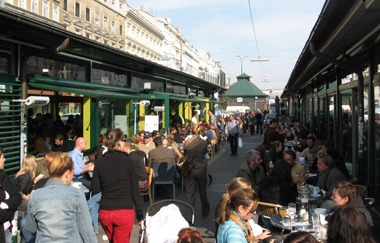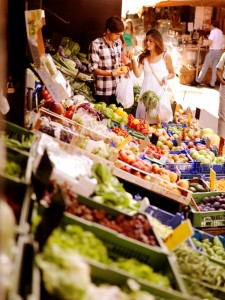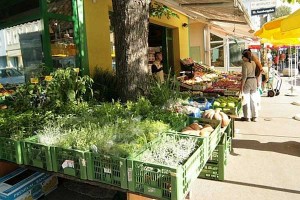Viennese Markets – Part 3

Expanding your culinary horizons – at first hand
Fresh fruit and vegetables from Austria, meat from organic farmers, cheese from alpine pastures, bread from Austria guaranteed free from genetic modification – or perhaps you prefer the finest sea fish, a special Indian curry mixture, original Japanese dough leaves, or sweet, dried fruits from the Orient? At Vienna’s markets, you’ll find delicacies from all over the world. Following our excursion into the history of Vienna’s open-air markets in part 2, we’ve now come back to the present.
Viennese markets today
Currently, there are 26 markets in Vienna, which accommodate 900 permanent market businesses, 600 daily marketers (farmers and dealers), as well as 4000 workers on their approximately 90,000 m2 of total market area. A distinction is made between retail markets (open from Monday through Saturday) and temporary markets (farmers’ markets that are only open on specific days of the week). The Viennese markets achieve an annual turnover of 300 million euros, which corresponds to 4% of total trade in Vienna (source: http://de.wikipedia.org/wiki/Liste_der_Wiener_M%C3%A4rkte).
Writing about all of the markets in Vienna would be beyond the scope of this blog, although I can’t deprive you of a couple of selected locations which I’d therefore like to introduce to you. Yet you need to discover these shopping paradises yourself, in person!
The Naschmarkt in the 6th District
Surely the most popular Viennese market, the Naschmarkt, is based on the “Aschenmarkt,” first mentioned in 1791 and located between the then-Freihaus and the Wienfluss (Vienna River). The milk pails made of ash wood, with which milk was collected, were described as “Asch” (ash). The fruit stands from the Freyung and the Burgtor were moved to this location at the end of the 18th century. The “Naschmarkt” continued to grow and became more and more true to its name, which it officially received in 1905. After the Wienfluss regulation and the superstructure construction by Otto Wager, the Naschmarkt was relocated to its present site. The stands, designed back then by Friedrich Jäckel and still typical today, were opened in 1916. The site of today’s Flea Market on Saturdays was once covered by wholesale market halls, which were torn down in 1972 after the Inzersdorf Grossmarkt was brought into operation.
Today, the Naschmarkt (in walking distance to the Schick-Hotel Erzherzog Rainer) in particular presents itself as a cultural melting pot. With its 2.3 hectares extending from Getreidemarkt to Kettenbrückengasse, it is the city’s largest market. More than 150 market stands (fixed and temporary) with all sorts of delicacies and specialties from all corners of the earth, together with visitors from all over the world, represent international flair. You look, purchase, take photos – and likewise enjoy many international delicacies in the numerous gastronomy businesses on-site.
The Sonnbergmarkt in the 19th District
Somewhat younger and significantly smaller than the Naschmarkt is the Sonnbergmarkt, which is among the insiders’ tips when it comes to the Viennese markets. Built between the wars, this somewhat hidden gem succeeded in becoming a genuine “in” market next to its big brother the Naschmarkt. The Sonnbergmarkt may be small, but it’s all the finer for it.
The offer is well-sorted and of the best quality. The first-class advice and the almost familial atmosphere make for its truly outstanding reputation, as evidenced by the high density of celebrities at the market. In 2011, comprehensive reconstruction was completed, so that people can continue to be catered to as they try things and shop.
In the fourth and last part of this series, I’ll introduce you to a couple Viennese markets – to whet your appetite once and for all.
Image credits: © www.peterrigaud.com , www.wien.gv.at , www.wien-vienna.at












